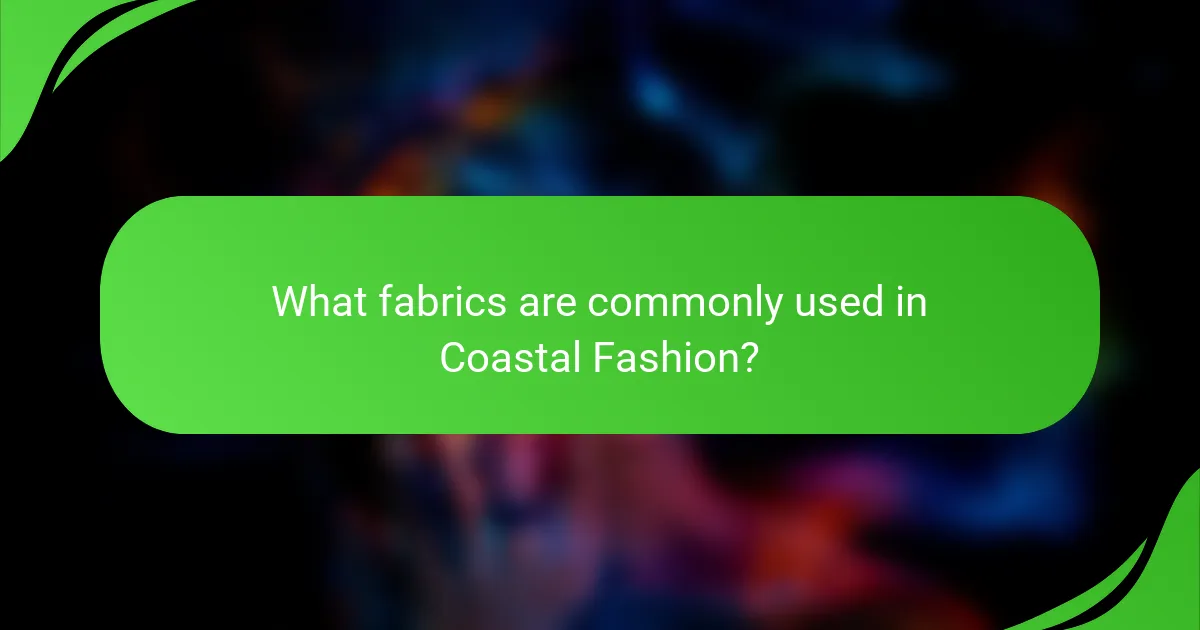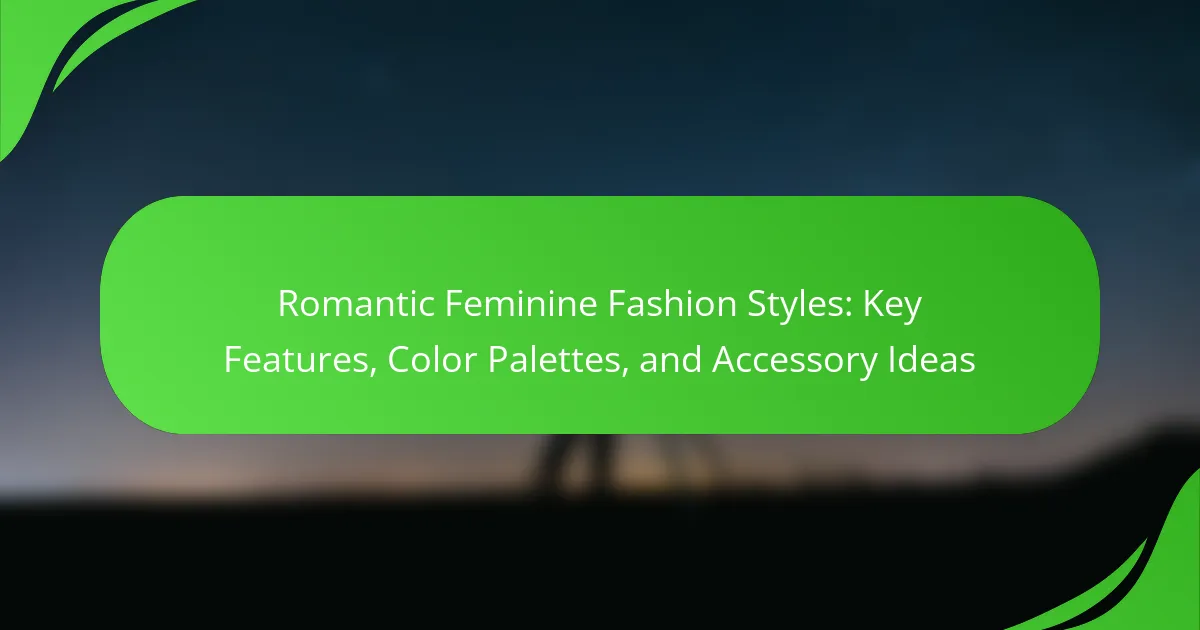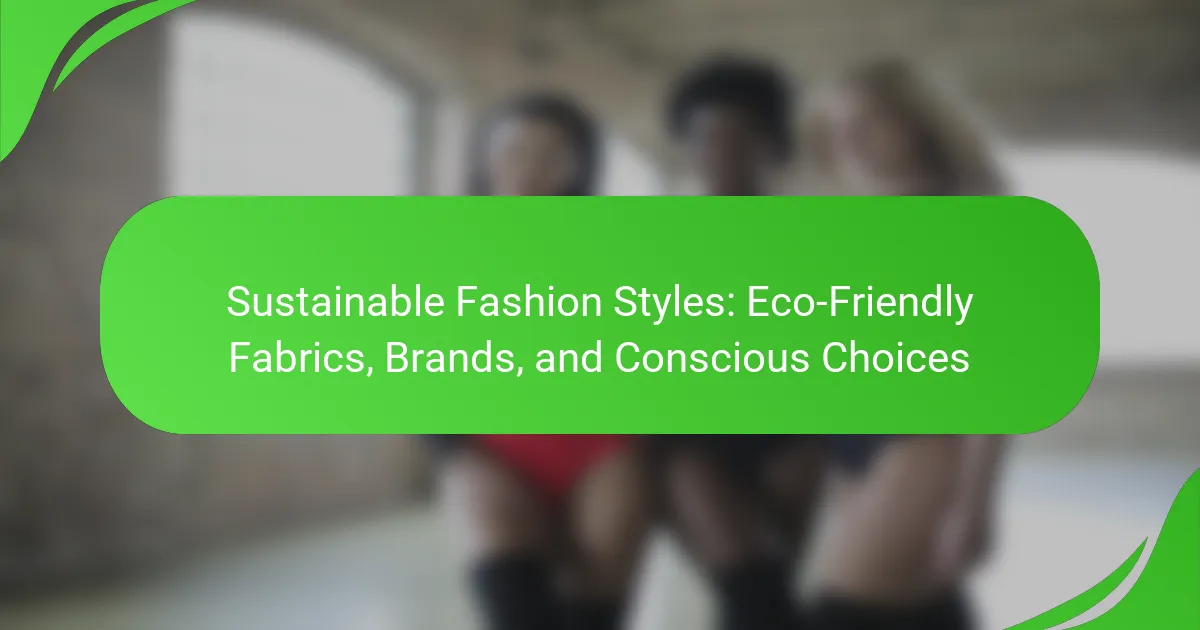Coastal fashion styles encompass clothing trends inspired by beach and seaside environments, characterized by light, breathable fabrics ideal for warm weather. Key fabrics include cotton, linen, and chambray, which offer comfort and a relaxed aesthetic. Common elements of coastal fashion feature loose-fitting garments in soft pastels and ocean-inspired hues, complemented by accessories such as straw hats, sunglasses, and beach bags. This style reflects a laid-back lifestyle, appealing to individuals who enjoy beach activities and outdoor leisure, while prioritizing both comfort and visual appeal.

What are Coastal Fashion Styles?
Coastal fashion styles are clothing trends inspired by beach and seaside environments. They emphasize light, breathable fabrics suitable for warm weather. Common elements include loose-fitting garments and relaxed silhouettes. Typical colors are soft pastels and ocean-inspired hues. Fabrics often used are cotton, linen, and lightweight knits. Accessories like straw hats and sandals complement these styles. Coastal fashion reflects a laid-back lifestyle and comfort. It is popular among individuals who enjoy beach activities and outdoor leisure.
How do Coastal Fashion Styles reflect beach culture?
Coastal fashion styles reflect beach culture through their emphasis on comfort, functionality, and vibrant aesthetics. These styles often feature lightweight fabrics that promote breathability, essential for warm beach environments. Common materials include cotton, linen, and quick-dry synthetics, which enhance wearability during water activities.
Color palettes in coastal fashion typically draw inspiration from ocean hues, sandy shores, and coastal flora. Patterns such as stripes, floral prints, and tropical motifs are prevalent, embodying the relaxed vibe of beach life. Footwear choices include sandals and flip-flops, designed for ease and practicality on sandy surfaces.
Accessories like wide-brimmed hats and sunglasses serve both fashion and sun protection needs. The overall look is designed to be laid-back yet stylish, allowing individuals to transition seamlessly from beach activities to social gatherings. This fashion style is a direct reflection of the leisure-oriented lifestyle associated with coastal living.
What are the historical influences on Coastal Fashion Styles?
Coastal fashion styles have been influenced by various historical factors. The maritime culture shaped early coastal attire, emphasizing practicality and comfort. In the 19th century, European seaside resorts popularized light fabrics and vibrant colors. The influence of tropical climates introduced materials like linen and cotton, suitable for warm weather. Additionally, the rise of surf culture in the 20th century brought board shorts and casual beachwear into mainstream fashion. Iconic figures, such as movie stars in beach films, further popularized coastal styles. The evolution of fashion trends has continued to reflect regional characteristics, including local textiles and traditional designs.
How do Coastal Fashion Styles vary across different regions?
Coastal fashion styles vary significantly across different regions due to climate, culture, and local aesthetics. In tropical regions, lightweight fabrics like cotton and linen dominate. Bright colors and floral patterns are popular, reflecting the vibrant environment. In contrast, Mediterranean coastal styles often feature earthy tones and tailored silhouettes. These styles incorporate breathable fabrics but maintain a more structured look.
In the northern coastal areas, such as New England, fashion tends to include layering for warmth. This includes heavier fabrics like wool and flannel, often in muted colors. Accessories such as scarves and hats are common to combat the chill.
The Caribbean showcases relaxed, casual styles with an emphasis on comfort. Swimwear and cover-ups are essential, often adorned with lively prints.
Each region’s unique cultural influences also shape its coastal fashion. For instance, California beach culture embraces a laid-back vibe with surf-inspired clothing. This includes board shorts and casual tees, often paired with flip-flops.
Overall, coastal fashion is a reflection of the local environment and lifestyle, resulting in diverse styles across regions.
What are the key trends in Coastal Fashion Styles?
Key trends in coastal fashion styles include lightweight fabrics, vibrant colors, and relaxed silhouettes. Lightweight fabrics such as linen and cotton are popular for their breathability. Vibrant colors often reflect the ocean and beach, incorporating blues, greens, and corals. Relaxed silhouettes provide comfort and ease, making them ideal for warm weather. Additionally, nautical stripes and tropical prints are frequently seen in coastal fashion. Accessories like wide-brimmed hats and oversized sunglasses complement these styles. Footwear trends feature espadrilles and flip-flops for casual wear. These trends cater to both functionality and aesthetic appeal in coastal environments.
Which colors are trending in Coastal Fashion this season?
Soft pastels, ocean blues, and sandy neutrals are trending in Coastal Fashion this season. These colors reflect the serene coastal environment. Soft pastels like mint green and blush pink evoke a light, airy feel. Ocean blues range from deep navy to light turquoise, mimicking the sea. Sandy neutrals include beige and taupe, representing beach elements. This color palette enhances the relaxed, breezy vibe of coastal styles. Fashion designers are incorporating these hues into their collections. The popularity of these colors aligns with the seasonal shift towards lighter, more vibrant looks.
What patterns and prints are popular in Coastal Fashion Styles?
Popular patterns and prints in Coastal Fashion Styles include stripes, florals, and nautical themes. Stripes often feature bold colors, reflecting the seaside atmosphere. Floral prints capture the essence of beach blooms and tropical vibes. Nautical themes incorporate anchors, boats, and marine motifs, emphasizing coastal living. These patterns are commonly seen in lightweight fabrics suitable for warm weather. The prevalence of these designs showcases their appeal in summer collections. Coastal fashion often embraces bright and airy colors, enhancing the overall aesthetic.

What fabrics are commonly used in Coastal Fashion?
Common fabrics used in Coastal Fashion include cotton, linen, and chambray. Cotton is breathable and comfortable, making it ideal for warm weather. Linen is lightweight and has a natural texture, perfect for a relaxed look. Chambray mimics denim but is lighter, offering a casual appearance. These fabrics are favored for their ability to keep cool in humid climates. Additionally, they are often used in beachwear and casual outfits. Coastal fashion prioritizes comfort and style, which these fabrics provide effectively.
How do fabric choices impact comfort and style?
Fabric choices significantly impact both comfort and style in coastal fashion. Natural fibers like cotton and linen offer breathability, enhancing comfort in warm weather. These fabrics wick moisture away from the skin, promoting a cool feeling. In contrast, synthetic materials may trap heat, reducing comfort during hot days. Style is influenced by the texture and drape of fabrics. Lightweight, flowing fabrics create a relaxed, beachy aesthetic. Patterns and colors in fabric choices also contribute to the overall look, aligning with coastal themes. For example, vibrant prints can evoke a summery vibe. Thus, selecting the right fabric is crucial for achieving both comfort and style in coastal fashion.
What are the best breathable fabrics for beachwear?
The best breathable fabrics for beachwear include cotton, linen, and rayon. Cotton is lightweight and allows for air circulation, making it comfortable in hot weather. Linen is known for its moisture-wicking properties and quick-drying capabilities. Rayon, made from natural fibers, is soft and breathable, providing comfort during beach activities. These fabrics help to keep the body cool and dry, essential for beachwear.
How do different fabrics affect the durability of Coastal Fashion?
Different fabrics significantly impact the durability of Coastal Fashion. Fabrics such as cotton and linen are breathable but may wear out faster in harsh coastal conditions. Synthetic materials like polyester and nylon offer greater resistance to saltwater and UV rays. These synthetic options tend to maintain their shape and color longer than natural fibers. Additionally, blends of fabrics can enhance durability while retaining comfort. For example, a cotton-polyester blend combines breathability with increased strength. Research indicates that polyester can last up to five times longer than cotton in outdoor conditions. Therefore, the choice of fabric is crucial for the longevity of Coastal Fashion items.
What sustainable fabric options are available for Coastal Fashion?
Sustainable fabric options for Coastal Fashion include organic cotton, hemp, and Tencel. Organic cotton is grown without synthetic pesticides or fertilizers. It is biodegradable and has a lower environmental impact. Hemp is a durable material that requires minimal water and no pesticides. It also enriches the soil as it grows. Tencel, made from sustainably sourced wood pulp, uses a closed-loop process that recycles water and solvents. These fabrics align with eco-friendly practices, making them ideal for beachwear.
How do eco-friendly fabrics contribute to Coastal Fashion Styles?
Eco-friendly fabrics enhance Coastal Fashion Styles by promoting sustainability and style. These materials often include organic cotton, linen, and recycled fibers. They align with the coastal aesthetic, which emphasizes natural beauty and environmental consciousness. Eco-friendly fabrics are breathable and lightweight, ideal for warm coastal climates. Additionally, they often feature vibrant colors and patterns that reflect coastal themes. The use of such fabrics reduces environmental impact, appealing to eco-conscious consumers. Research indicates that sustainable fashion is increasingly favored, with 66% of global consumers willing to pay more for sustainable brands. This shift supports the integration of eco-friendly fabrics into coastal fashion trends.
What brands prioritize sustainable fabrics in their Coastal collections?
Patagonia and Outerknown prioritize sustainable fabrics in their Coastal collections. Patagonia uses recycled materials and organic cotton in its products. Outerknown emphasizes eco-friendly textiles, including organic and regenerated fibers. Both brands are committed to reducing environmental impact. Patagonia has a long-standing reputation for sustainability since its founding in 1973. Outerknown, co-founded by surfer Kelly Slater, focuses on ethical production practices. These brands exemplify a commitment to sustainability in coastal fashion.

What accessories complement Coastal Fashion Styles?
Accessories that complement Coastal Fashion Styles include straw hats, sunglasses, and beach bags. Straw hats provide sun protection while adding a stylish touch. Sunglasses protect the eyes and enhance the overall look. Beach bags are practical for carrying essentials and often feature vibrant colors or patterns. Other accessories like sandals and lightweight scarves also fit well with coastal aesthetics. These items typically use breathable materials suitable for warm weather. Coastal fashion often emphasizes a relaxed and effortless vibe, which these accessories help achieve. The combination of these elements creates a cohesive coastal look.
What types of accessories are essential for beach lovers?
Essential accessories for beach lovers include beach towels, umbrellas, and sunglasses. Beach towels provide comfort and warmth on the sand. They also serve as a space to relax and dry off after swimming. Umbrellas offer shade and protection from harmful UV rays. Sunglasses protect the eyes from glare and enhance visibility. Other important accessories are flip-flops, beach bags, and hats. Flip-flops are convenient for walking on hot sand. Beach bags help carry essentials like sunscreen and snacks. Hats shield the face from the sun, preventing sunburn. These accessories enhance the beach experience and promote safety.
How do hats enhance Coastal Fashion looks?
Hats enhance Coastal Fashion looks by adding style and functionality. They provide sun protection, which is crucial in coastal environments. A well-chosen hat complements outfits, creating a cohesive look. Wide-brimmed hats are particularly popular for their dramatic flair. They can be made from lightweight materials, ensuring comfort in warm weather. Hats also serve as a statement accessory, reflecting personal style. Fashion trends often highlight hats as essential elements in coastal wardrobes. The right hat can elevate casual beach attire into chic ensembles.
What role do bags play in Coastal Fashion styling?
Bags are essential accessories in Coastal Fashion styling. They complement beachwear while providing functionality. Coastal bags often feature lightweight materials and vibrant colors. These bags enhance the relaxed, casual vibe typical of coastal looks. They are designed to hold essentials like sunscreen, towels, and swimwear. Popular styles include tote bags and crossbody bags. The choice of bag reflects personal style and seaside aesthetics. Overall, bags play a pivotal role in balancing style and practicality in coastal fashion.
How can accessories elevate a Coastal Fashion outfit?
Accessories can elevate a Coastal Fashion outfit by adding visual interest and enhancing the overall aesthetic. They provide a way to express personal style while complementing the relaxed vibe of coastal attire. Items like wide-brimmed hats offer sun protection and create a chic look. Statement jewelry, such as shell necklaces, can reflect the beach theme. Lightweight scarves can add color and texture without overwhelming the outfit. Footwear like espadrilles or sandals contributes to comfort and style. Additionally, functional bags, such as tote bags, are practical for beach outings and align with the coastal theme. Overall, accessories play a crucial role in transforming a basic outfit into a fashionable ensemble.
What are the best practices for mixing and matching accessories?
The best practices for mixing and matching accessories include choosing complementary colors and textures. Start by selecting a base color for your outfit. Then, choose accessories that enhance this color without clashing. For example, if wearing a blue dress, opt for accessories in shades of white, beige, or gold.
Layering different textures adds depth. Combine smooth materials like silk with rougher ones like woven straw. Balance bold patterns with solid colors to avoid overwhelming the look. For instance, if you wear a patterned scarf, keep other accessories simple.
Consider the occasion when selecting accessories. Casual outings allow for playful combinations, while formal events require more refined choices. Proportion is key; larger accessories work well with simpler outfits, while delicate pieces suit more intricate styles.
Finally, personal style should guide your choices. Experiment with different combinations to find what feels authentic. This approach not only enhances your overall look but also showcases your unique fashion sense.
How do seasonal trends influence accessory choices in Coastal Fashion?
Seasonal trends significantly influence accessory choices in Coastal Fashion. During warmer months, lightweight and breathable materials are preferred. Accessories like wide-brimmed hats and sunglasses become essential for sun protection. Bright colors and floral patterns are popular, reflecting the vibrant summer atmosphere. In contrast, cooler seasons see a shift towards layered accessories. Scarves and lightweight wraps are favored for added warmth. Earthy tones and muted colors dominate fall and winter collections. Seasonal trends dictate not only style but also functionality in accessory selection. This adaptability ensures that coastal fashion remains relevant and appealing throughout the year.
What tips can beach lovers follow to embrace Coastal Fashion Styles?
Beach lovers can embrace Coastal Fashion Styles by choosing light and breathable fabrics. Fabrics such as linen, cotton, and rayon are ideal for warm weather. Bright colors and nautical stripes reflect the coastal vibe. Accessories like wide-brimmed hats and oversized sunglasses enhance the look. Footwear should be comfortable, with options like flip-flops or espadrilles. Layering with light cover-ups is practical for transitioning from beach to casual outings. Incorporating beach-themed jewelry adds a playful touch. Lastly, opting for sustainable brands supports eco-friendly fashion choices.
Coastal Fashion Styles encompass clothing trends inspired by beach environments, characterized by light, breathable fabrics such as cotton and linen, and relaxed silhouettes in soft pastels and ocean hues. This article explores how these styles reflect beach culture, their historical influences, and regional variations. Key trends, popular patterns, and sustainable fabric options are highlighted, alongside essential accessories that complement coastal looks. Practical tips for beach lovers on embracing these styles are also provided, emphasizing comfort, functionality, and eco-friendliness.


